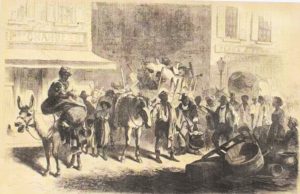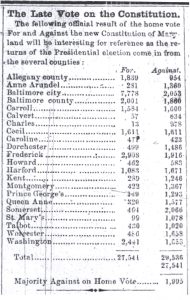Article 24 of the Declaration of Rights of the Maryland Constitution of 1864.
Art. 24. That hereafter, in this State, there shall be neither slavery nor involuntary servitude, except in punishment of crime, whereof the party shall have been duly convicted: and all persons held to service or labor as slaves are hereby declared free.
The State of Maryland celebrates Emancipation Day on November 1. On this day 160 years in 1864, a referendum was passed by a very narrow margin approving a new Constitution for Maryland that included freeing Maryland’s enslaved. In Southern Maryland, 33,295 enslaved persons were “free at last”. This included Blacks across the four counties in Southern Maryland who made up over 60% of the population.
At the start of the Civil War, Maryland was designated as a “free state” because Maryland did not secede from the Union with the rest of the Confederacy. President Lincoln’s Emancipation Proclamation, effective January 1, 1863, only applied to the seceding States. Therefore, Maryland was able to continue the practice of enslavement.
While enslavement continued in Maryland, it was a time of turmoil for both the enslaver and the enslaved. Washington, D.C. freed their enslaved in April 1862. During this time Maryland enslaved had several paths to freedom. Maryland enslaved fled in significant numbers to freedom in Washington, D.C. Also, Federal troops were stationed in Maryland to protect the Capitol and the enslaved fled to those units. Through the Emancipation Proclamation, African Americans could enroll in the Union armed forces starting in January 1863. Several regiments of colored troops were formed in Maryland, with a major training center in Southern Maryland at Camp Stanton in Benedict; it opened in October 1863. Overall, 8,700 African Americans in Maryland left their owners or enrolled as free Blacks to fight for the Union.
Support for emancipation varied significantly across Maryland according to the county’s enslaved percentage. The impact of emancipation on Southern Maryland was more significant on the region’s economy than elsewhere in the State. The chart below shows the number of enslaved and free Blacks compared with the total population for each Southern Maryland County.
| Data in 1860 by County | Total Population | Enslaved | Free Black | Blacks as a % of the Population |
| Calvert County | 10,447 | 4,609 | 1,841 | 62% |
| Charles County | 16,517 | 9,653 | 1,068 | 65% |
| Prince Georges County | 23,327 | 12,479 | 1,198 | 59% |
| St. Mary’s County | 15,213 | 6,549 | 1,866 | 55% |
| State of Maryland | 687,049 | 87,189 | 83,942 | 25% |

Opposition to the referendum for the new state constitution that included emancipation was strong across Southern Maryland. Enslavement was deeply embedded in Southern Maryland. The economy of the region was based on enslaved labor. Blacks made up a much higher proportion of the population there than in the State as a whole, and most were enslaved. The voting population was afraid that their whole economy would collapse without the benefit of slave labor. The referendum vote by county reflected this.
Vote on the Maryland Constitution referendum by Southern Maryland Counties
| County | For | Against |
| Calvert | 57 | 634 |
| Charles | 13 | 978 |
| Prince Georges | 149 | 1,293 |
| St. Mary’s | 99 | 1,078 |
As with current elections, there were claims that unscrupulous tactics were used. Supposedly, a train

was provided to bring 1,000 workers from the Navy Yard to vote “for”. Arrangements were made to have soldiers deployed away from Maryland be able to vote, most of whom were in Virginia. Voting records show that most of their votes were for constitutional change. The final tally: 30,174 for, 29,799 against. Only 375 votes ratified the new Constitution.
After Maryland’s emancipation, Southern Maryland experienced a hard time without the free labor of the enslaved to tend their fields. It was difficult for farmers and plantation owners to continue. Many sold large portions of land to the previously enslaved. Others hired the previously enslaved to work the land or do other jobs. The concept of sharecropping began a practice that put many in debt to the landowner.
Though the new constitution freed people of African descent it did not grant them citizenship this would happen with the 14th Amendment to the United States Constitution on July 9, 1868.
Additional Resources:
A Guide to the History of Slavery in Maryland, Maryland State Archives, Annapolis, Maryland and the University of Maryland, College Park, Maryland. EnslavedMD pages 15-17
The Maryland Constitution of 1864, William Starr Rich, Maryland Internet Archives. This booklet tells the story of the development of the new constitution as observed 35 years later by historian William Starr Myers. He notes the political movement behind it, the debates, and the final passage.
Emancipation Day – Southern Maryland Equity in History Timeline
Maryland Emancipation/Counting, Landmarks, Allen Browne
Maryland Emancipation Day: 375 absentee ballots ended slavery in 1864 – The Washington Post October 31, 2020
Camp Stanton – Southern Maryland Equity in History Coalition
The Legacy of Slavery in Maryland, Maryland State Archives.
Legacy of Slavery in Maryland: Maryland Census Data 1860
